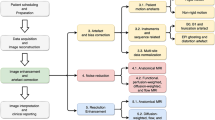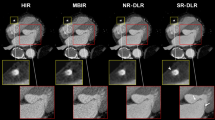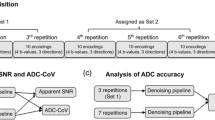Abstract
Objective
This study combines a deep image prior with low-rank subspace modeling to enable real-time (free-breathing and ungated) functional cardiac imaging on a commercial 0.55 T scanner.
Materials and methods
The proposed low-rank deep image prior (LR-DIP) uses two u-nets to generate spatial and temporal basis functions that are combined to yield dynamic images, with no need for additional training data. Simulations and scans in 13 healthy subjects were performed at 0.55 T and 1.5 T using a golden angle spiral bSSFP sequence with images reconstructed using \({l}_{1}\)-ESPIRiT, low-rank plus sparse (L + S) matrix completion, and LR-DIP. Cartesian breath-held ECG-gated cine images were acquired for reference at 1.5 T. Two cardiothoracic radiologists rated images on a 1–5 scale for various categories, and LV function measurements were compared.
Results
LR-DIP yielded the lowest errors in simulations, especially at high acceleration factors (R \(\ge\) 8). LR-DIP ejection fraction measurements agreed with 1.5 T reference values (mean bias − 0.3% at 0.55 T and − 0.2% at 1.5 T). Compared to reference images, LR-DIP images received similar ratings at 1.5 T (all categories above 3.9) and slightly lower at 0.55 T (above 3.4).
Conclusion
Feasibility of real-time functional cardiac imaging using a low-rank deep image prior reconstruction was demonstrated in healthy subjects on a commercial 0.55 T scanner.











Similar content being viewed by others
Data availability
Data presented in this study are available upon reasonable request.
References
Bogaert J, Dymarkowski S, Taylor AM, Muthurangu V (2012) Clinical Cardiac MRI, 2nd edn. Springer-Verlag, Berlin Heidelberg
Pruessmann KP, Weiger M, Scheidegger MB, Boesiger P (1999) SENSE: Sensitivity encoding for fast MRI. Magn Reson Med 42:952–962
Pruessmann KP, Weiger M, Boesiger P (2001) Sensitivity encoded cardiac MRI. J Cardiovasc Magn Reson 3:1–9
Griswold MA, Jakob PM, Heidemann RM, Nittka M, Jellus V, Wang J, Kiefer B, Haase A (2002) Generalized Autocalibrating Partially Parallel Acquisitions (GRAPPA). Magn Reson Med 47:1202–1210
Kellman P, Epstein FH, McVeigh ER (2001) Adaptive sensitivity encoding incorporating temporal filtering (TSENSE). Magn Reson Med 45:846–852
Breuer FA, Kellman P, Griswold MA, Jakob PM, Breuer FA, Kellman P, Griswold MA, Jakob PM (2005) Dynamic autocalibrated parallel imaging using temporal GRAPPA (TGRAPPA). Magn Reson Med 53:981–985
Uecker M, Lai P, Murphy MJ, Virtue P, Elad M, Pauly JM, Vasanawala SS, Lustig M (2014) ESPIRiT - An eigenvalue approach to autocalibrating parallel MRI: Where SENSE meets GRAPPA. Magn Reson Med 71:990–1001
Tsao J, Boesiger P, Pruessmann KP (2003) k-t BLAST and k-t SENSE: Dynamic MRI With High Frame Rate Exploiting Spatiotemporal Correlations. Magn Reson Med 50:1031–1042
Huang F, Akao J, Vijayakumar S, Duensing GR, Limkeman M (2005) K-t GRAPPA: A k-space implementation for dynamic MRI with high reduction factor. Magn Reson Med 54:1172–1184
Lustig M, Donoho D, Pauly JM (2007) Sparse MRI: The application of compressed sensing for rapid MR imaging. Magn Reson Med 58:1182–1195
Feng L, Srichai MB, Lim RP, Harrison A, King W, Adluru G, Dibella EVR, Sodickson DK, Otazo R, Kim D (2013) Highly accelerated real-time cardiac cine MRI using k-t SPARSE-SENSE. Magn Reson Med 70:64–74
Feng L, Grimm R, Obias BKT, Chandarana H, Kim S, Xu J, Axel L, Sodickson DK, Otazo R (2014) Golden-angle radial sparse parallel MRI: combination of compressed sensing, parallel imaging, and golden-angle radial sampling for fast and flexible dynamic volumetric MRI. Magn Reson Med 72:707–717
Jung H, Park J, Yoo J, Ye JC (2010) Radial k-t FOCUSS for high-resolution cardiac cine MRI. Magn Reson Med 63:68–78
Zhao B, Haldar JP, Brinegar C, Liang Z-P (2010) Low rank matrix recovery for real-time cardiac MRI. 2010 IEEE Int. Symp. Biomed. Imaging From Nano to Macro. 11:996–999
Lingala SG, Hu Y, Dibella E, Jacob M (2011) Accelerated dynamic MRI exploiting sparsity and low-rank structure: k-t SLR. IEEE Trans Med Imaging 30:1042–1054
Pedersen H, Kozerke S, Ringgaard S, Nehrke K, Won YK (2009) K-t PCA: Temporally constrained k-t BLAST reconstruction using principal component analysis. Magn Reson Med 62:706–716
Otazo R, Candès E, Sodickson DK (2015) Low-rank plus sparse matrix decomposition for accelerated dynamic MRI with separation of background and dynamic components. Magn Reson Med 73:1125–1136
Wang D, Smith DS, Yang X (2020) Dynamic MR image reconstruction based on total generalized variation and low-rank decomposition. Magn Reson Med 83:2064–2076
Campbell-Washburn AE, Ramasawmy R, Restivo MC, Bhattacharya I, Basar B, Herzka DA, Hansen MS, Rogers T, Patricia Bandettini W, McGuirt DR, Mancini C, Grodzki D, Schneider R, Majeed W, Bhat H, Xue H, Moss J, Malayeri AA, Jones EC, Koretsky AP, Kellman P, Chen MY, Lederman RJ, Balaban RS (2019) Opportunities in interventional and diagnostic imaging by using high-performance low-field-strength MRI. Radiology 293:384–393
Simonetti OP, Ahmad R (2017) Low-Field Cardiac Magnetic Resonance Imaging: A Compelling Case for Cardiac Magnetic Resonance’s Future. Circ Cardiovasc Imaging 10:e005446
Hoult DI, Phil D (2000) Sensitivity and power deposition in a high-field imaging experiment. J Magn Reson Imaging 12:46–67
Strach K, Naehle CP, Mühlsteffen A, Hinz M, Bernstein A, Thomas D, Linhart M, Meyer C, Bitaraf S, Schild H, Sommer T (2010) Low-field magnetic resonance imaging: Increased safety for pacemaker patients? Europace 12:952–960
Bandettini WP, Shanbhag SM, Mancini C, McGuirt DR, Kellman P, Xue H, Henry JL, Lowery M, Thein SL, Chen MY, Campbell-Washburn AE (2020) A comparison of cine CMR imaging at 0.55 T and 1.5 T. J Cardiovasc Magn Reson 22:37
Srinivasan S, Ennis DB (2015) Optimal flip angle for high contrast balanced SSFP cardiac cine imaging. Magn Reson Med 73:1095–1103
Restivo MC, Ramasawmy R, Bandettini WP, Herzka DA, Campbell-Washburn AE (2020) Efficient spiral in-out and EPI balanced steady-state free precession cine imaging using a high-performance 0.55T MRI. Magn Reson Med 84:2364–2375
Tian Y, Cui SX, Lim Y, Lee NG, Zhao Z, Nayak KS (2022) Contrast-optimal simultaneous multi-slice bSSFP cine cardiac imaging at 055 T. Magn Reson Med. https://doi.org/10.1002/mrm.29472
Fyrdahl A, Seiberlich N (2022) Real-time Cardiac MRI at 0.55T using through-time spiral GRAPPA. Proc. 31st Annu. ISMRM. p 1843
Tian Y, Lim Y, Nayak KS (2022) Real-Time Water Fat Imaging at 0.55T with Spiral Out-In-Out-In Sampling. Proc. 31st Annual ISMRM. p 317
Küstner T, Fuin N, Hammernik K, Bustin A, Qi H, Hajhosseiny R, Masci PG, Neji R, Rueckert D, Botnar RM, Prieto C (2020) CINENet: deep learning-based 3D cardiac CINE MRI reconstruction with multi-coil complex-valued 4D spatio-temporal convolutions. Sci Rep 10:1–13
Sandino CM, Lai P, Vasanawala SS, Cheng JY (2021) Accelerating cardiac cine MRI using a deep learning-based ESPIRiT reconstruction. Magn Reson Med 85:152–167
El-Rewaidy H, Fahmy AS, Pashakhanloo F, Cai X, Kucukseymen S, Csecs I, Neisius U, Haji-Valizadeh H, Menze B, Nezafat R (2021) Multi-domain convolutional neural network (MD-CNN) for radial reconstruction of dynamic cardiac MRI. Magn Reson Med 85:1195–1208
Jaubert O, Montalt-Tordera J, Knight D, Coghlan GJ, Arridge S, Steeden JA, Muthurangu V (2021) Real-time deep artifact suppression using recurrent U-Nets for low-latency cardiac MRI. Magn Reson Med 86:1904–1916
Shen D, Ghosh S, Haji-Valizadeh H, Pathrose A, Schiffers F, Lee DC, Freed BH, Markl M, Cossairt OS, Katsaggelos AK, Kim D (2021) Rapid reconstruction of highly undersampled, non-Cartesian real-time cine k-space data using a perceptual complex neural network (PCNN). NMR Biomed 34:e4405
Hauptmann A, Arridge S, Lucka F, Muthurangu V, Steeden JA (2019) Real-time cardiovascular MR with spatio-temporal artifact suppression using deep learning-proof of concept in congenital heart disease. Magn Reson Med 81:1143–1156
Morales MA, Assana S, Cai X, Chow K, Haji-Valizadeh H, Sai E, Tsao C, Matos J, Rodriguez J, Berg S, Whitehead N, Pierce P, Goddu B, Manning WJ, Nezafat R (2022) An inline deep learning based free-breathing ECG-free cine for exercise cardiovascular magnetic resonance. J Cardiovasc Magn Reson 24:47
Ulyanov D, Vedaldi A, Lempitsky V (2018) Deep Image Prior. Proc. IEEE Comput. Soc. Conf. Comput. Vis. Pattern Recognit. IEEE Computer Society. 9446–9454
Chakrabarty P, Maji S (2019) The spectral bias of the deep image prior. arXiv Prepr. arXIV1912 08905
Laves M-H, Tölle M, Ortmaier T (2020) Uncertainty Estimation in Medical Image Denoising with Bayesian Deep Image Prior. Med Image Comput Comput Assist Interv. https://doi.org/10.48550/ARXIV.2008.08837
Lin YC, Huang HM (2020) Denoising of multi b-value diffusion-weighted MR images using deep image prior. Phys Med Biol. https://doi.org/10.1088/1361-6560/ab8105
Jafari R, Spincemaille P, Zhang J, Nguyen TD, Luo X, Cho J, Margolis D, Prince MR, Wang Y (2021) Deep neural network for water/fat separation: Supervised training, unsupervised training, and no training. Magn Reson Med 85:2263–2277
Hamilton JI (2022) A Self-Supervised Deep Learning Reconstruction for Shortening the Breathhold and Acquisition Window in Cardiac Magnetic Resonance Fingerprinting. Front Cardiovasc Med 9:928546
Yoo J, Jin KH, Gupta H, Yerly J, Stuber M, Unser M (2021) Time-Dependent Deep Image Prior for Dynamic MRI. IEEE Trans Med Imaging 40:3337–3348
Fessler J, Sutton B (2003) Nonuniform fast Fourier transforms using min-max interpolation. IEEE Trans Signal Process 51:560–574
Seiberlich N, Breuer FA, Blaimer M, Barkauskas K, Jakob PM, Griswold MA (2007) Non-Cartesian data reconstruction using GRAPPA operator gridding (GROG). Magn Reson Med 58:1257–1265
Segars WP, Sturgeon G, Mendonca S, Grimes J, Tsui BMW (2010) 4D XCAT phantom for multimodality imaging research. Med Phys 37:4902–4915
Winkelmann S, Schaeffter T, Koehler T, Eggers H, Doessel O (2007) An optimal radial profile order based on the Golden Ratio for time-resolved MRI. IEEE Trans Med Imaging 26:68–76
Yushkevich PA, Piven J, Hazlett HC, Smith RG, Ho S, Gee JC, Gerig G (2006) User-guided 3D active contour segmentation of anatomical structures: significantly improved efficiency and reliability. Neuroimage 31:1116–1128
Zou Q, Ahmed AH, Nagpal P, Kruger S, Jacob M (2021) Dynamic Imaging Using a Deep Generative SToRM (Gen-SToRM) Model. IEEE Trans Med Imaging 40:3102–3112
Acknowledgements
This work was supported by the Michigan Institute for Clinical & Health Research (MICHR) Grant UL1TR002240, Siemens Healthineers, and National Institutes of Health/National Heart, Lung, and Blood Institute (NIH/NHLBI) R01HL163030 and R01HL153034. The funders had no involvement with any aspect of the study design, data collection, interpretation of results, or manuscript preparation.
Funding
This work was supported by the Michigan Institute for Clinical & Health Research (MICHR) Grant UL1TR002240, Siemens Healthineers, and National Institutes of Health/National Heart, Lung, and Blood Institute (NIH/NHLBI) R01HL163030 and R01HL153034. The funders had no involvement with any aspect of the study design, data collection, interpretation of results, or manuscript preparation.
Author information
Authors and Affiliations
Contributions
A: study conception and design, critical revision; B: study conception and design, critical revision; G: analysis and interpretation of data, critical revision; H: study conception and design, acquisition of data, analysis and interpretation of data, drafting of manuscript, critical revision; S: study conception and design, analysis and interpretation of data, critical revision; T: analysis and interpretation of data, critical revision.
Corresponding author
Ethics declarations
Conflict of interest
Jesse Hamilton and Nicole Seiberlich receive research support from Siemens Healthineers (Erlangen, Germany).
Ethical standards
This study was IRB-approved. Written informed consent was obtained for all human subjects before they underwent MRI scans.
Additional information
Publisher's Note
Springer Nature remains neutral with regard to jurisdictional claims in published maps and institutional affiliations.
Supplementary Information
Below is the link to the electronic supplementary material.
Supplementary file2 Real-time 0.55T spiral images from one healthy subject at apical, medial, and basal slice positions. Images were reconstructed using (left column) l_1-ESPIRiT, (middle column) L+S matrix completion, and (right column) the proposed LR-DIP method. Relevant imaging parameters: 38 ms temporal resolution, 2.2 x 2.2 x 8.0 mm3, 280 x 280 mm2 FOV, R=8 (6 interleaves per frame). (MP4 467 KB)
Supplementary file3Real-time spiral images acquired at 0.55T from one healthy subject. Images were reconstructed using (left column) l_1-ESPIRiT, (middle column) L+S matrix completion, and (right column) the proposed LR-DIP method. Relevant imaging parameters: 38 ms temporal resolution, 2.2 x 2.2 x 8.0 mm3, 280 x 280 mm2 FOV, R=8 (6 interleaves per frame) (MP4 218 KB)
Supplementary file4Real-time spiral images acquired at 1.5T from the same subject shown in Online Resource 2. Images were reconstructed using (left) l_1-ESPIRiT, (middle column) L+S matrix completion, and (right column) the proposed LR-DIP method. Relevant imaging parameters: 41 ms temporal resolution, 1.5 x 1.5 x 8.0 mm3, 295 x 295 mm2 FOV, R=6 (8 interleaves per frame) (MP4 170 KB)
Supplementary file5 Reference breathheld and ECG-gated Cartesian cine scan acquired at 1.5T from the same subject shown in Online Resources 2-3. Relevant imaging parameters: 25 cardiac phases, 1.5 x 1.5 x 8.0 mm3, 340 x 336 mm2 FOV (MP4 102 KB)
Supplementary file6 Real-time 0.55T spiral images from one healthy subject in (first row) short-axis, (second row) long-axis, and (third row) four-chamber orientations. Images were reconstructed using (left column) l_1-ESPIRiT, (middle column) L+S matrix completion, and (right column) the proposed LR-DIP method. Relevant imaging parameters: 38 ms temporal resolution, 2.2 x 2.2 x 8.0 mm3, 280 x 280 mm2 FOV, R=8 (6 interleaves per frame) (MP4 641 KB)
Supplementary file7 Real-time 0.55T spiral images in a short-axis orientation with full coverage of the LV. Images were reconstructed using (first row) l_1-ESPIRiT, (second row) L+S matrix completion, and (third row) the proposed LR-DIP method. Relevant imaging parameters: 38 ms temporal resolution, 2.2 x 2.2 x 8.0 mm3, 280 x 280 mm2 FOV, R=8 (6 interleaves per frame)(MP4 545 KB)
Supplementary file8 Real-time 1.5T spiral images in a short-axis orientation with full coverage of the LV from the same subject as shown in Online Resource 6. Images were reconstructed using (first row) l_1-ESPIRiT, (second row) L+S matrix completion, and (third row) the proposed LR-DIP method. Relevant imaging parameters: 41 ms temporal resolution, 1.5 x 1.5 x 8.0 mm3, 295 x 295 mm2 FOV, R=6 (8 interleaves per frame). (MP4 1179 KB)
Supplementary file9Reference breathheld and ECG-gated Cartesian images acquired at 1.5T in a short-axis orientation with full coverage of the LV from the same subject as shown in Online Resources 6-7. Relevant imaging parameters: 25 cardiac phases, 1.5 x 1.5 x 8.0 mm3, 340 x 336 mm2 FOV (MP4 240 KB)
Supplementary file10Real-time spiral image at 0.55T with a temporal resolution of 76 ms and acceleration factor of R=4 (12 interleaves per frame). Images were reconstructed using (left) l_1-ESPIRiT, (middle) L+S matrix completion, and (right) the proposed LR-DIP method (MP4 133 KB)
Supplementary file11Real-time spiral image at 0.55T with a temporal resolution of 50 ms and acceleration factor of R=6 (8 interleaves per frame). Images were reconstructed using (left) l_1-ESPIRiT, (middle) L+S matrix completion, and (right) the proposed LR-DIP method (MP4 193 KB)
Supplementary file12 Real-time spiral image at 0.55T with a temporal resolution of 38 ms and acceleration factor of R=6 (6 interleaves per frame). Images were reconstructed using (left) l_1-ESPIRiT, (middle) L+S matrix completion, and (right) the proposed LR-DIP method (MP4 247 KB)
Supplementary file13 Real-time spiral image at 0.55T with a temporal resolution of 25 ms and acceleration factor of R=12 (4 interleaves per frame). Images were reconstructed using (left) l_1-ESPIRiT, (middle) L+S matrix completion, and (right) the proposed LR-DIP method (MP4 411 KB)
Supplementary file14 Real-time spiral image at 0.55T with a temporal resolution of 13 ms and acceleration factor of R=24 (2 interleaves per frame). Images were reconstructed using (left) l_1-ESPIRiT, (middle) L+S matrix completion, and (right) the proposed LR-DIP method (MP4 1036 KB)
Rights and permissions
Springer Nature or its licensor (e.g. a society or other partner) holds exclusive rights to this article under a publishing agreement with the author(s) or other rightsholder(s); author self-archiving of the accepted manuscript version of this article is solely governed by the terms of such publishing agreement and applicable law.
About this article
Cite this article
Hamilton, J.I., Truesdell, W., Galizia, M. et al. A low-rank deep image prior reconstruction for free-breathing ungated spiral functional CMR at 0.55 T and 1.5 T. Magn Reson Mater Phy 36, 451–464 (2023). https://doi.org/10.1007/s10334-023-01088-w
Received:
Revised:
Accepted:
Published:
Issue Date:
DOI: https://doi.org/10.1007/s10334-023-01088-w




